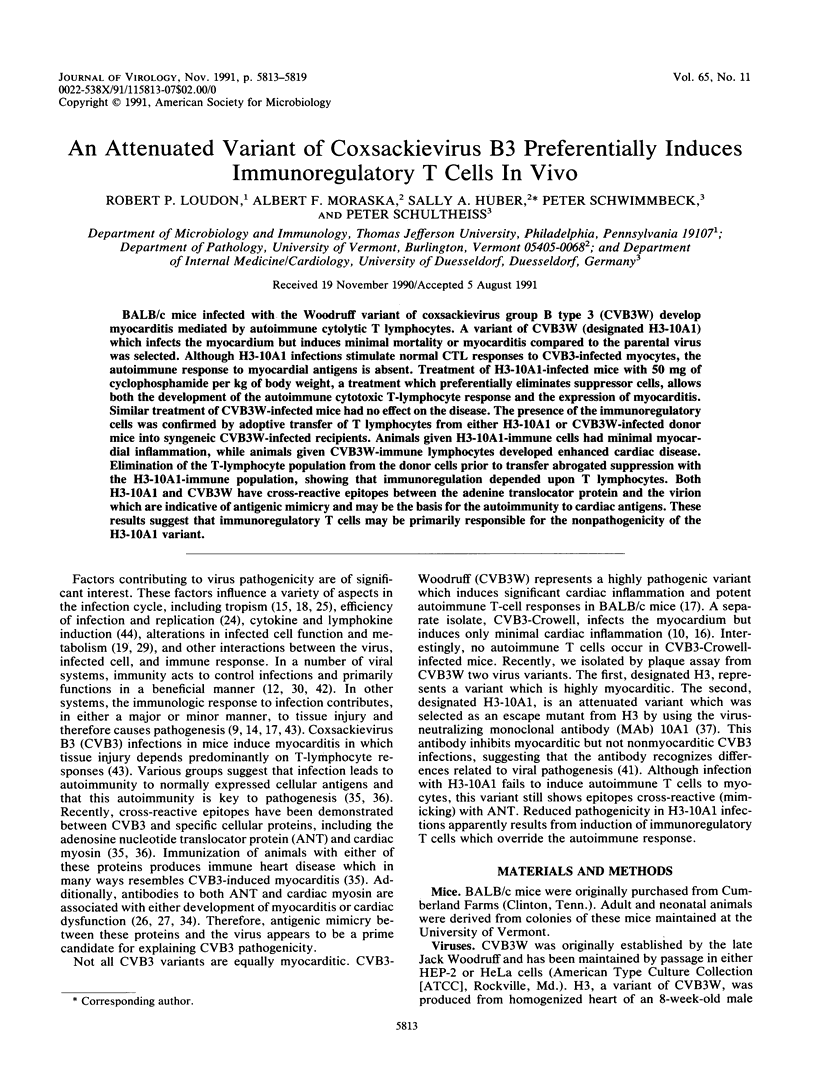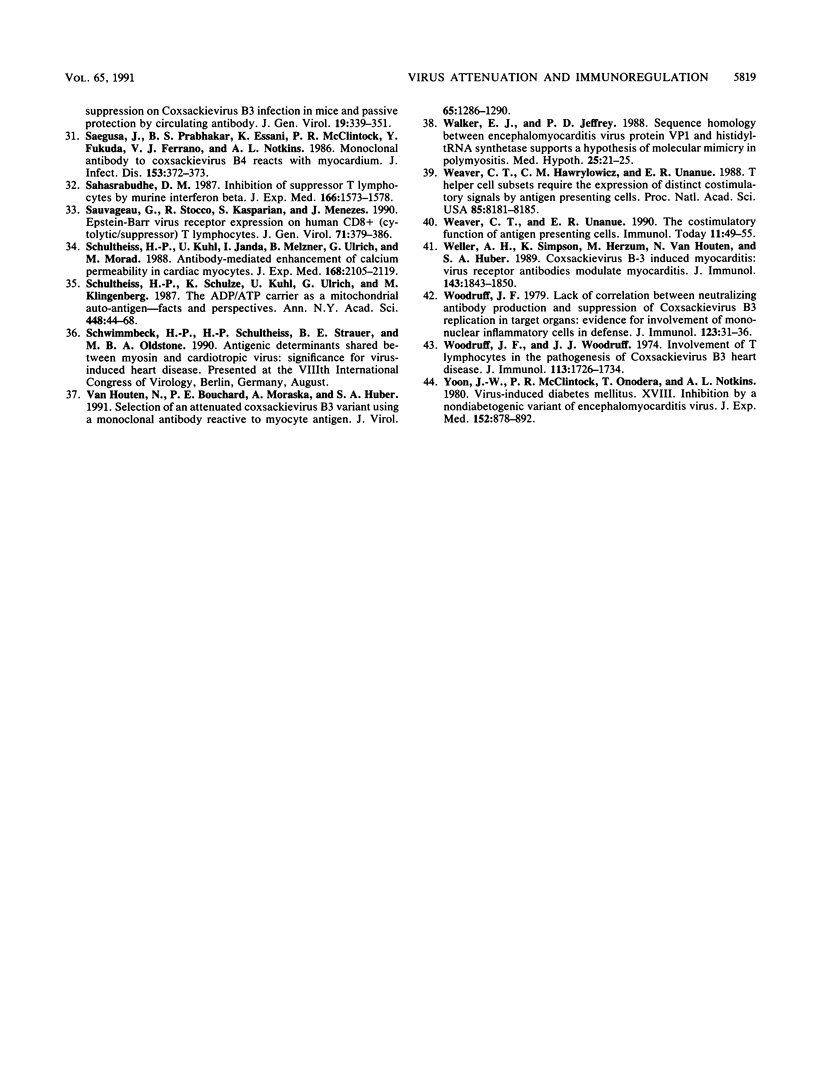Abstract
BALB/c mice infected with the Woodruff variant of coxsackievirus group B type 3 (CVB3W) develop myocarditis mediated by autoimmune cytolytic T lymphocytes. A variant of CVB3W (designated H3-10A1) which infects the myocardium but induces minimal mortality of myocarditis compared to the parental virus was selected. Although H3-10A1 infections stimulate normal CTL responses to CVB3-infected myocytes, the autoimmune response to myocardial antigens is absent. Treatment of H3-10A1-infected mice with 50 mg of cyclophosphamide per kg of body weight, a treatment which preferentially eliminates suppressor cells, allows both the development of the autoimmune cytotoxic T-lymphocyte response and the expression of myocarditis. Similar treatment of CVB3W-infected mice had no effect on the disease. The presence of the immunoregulatory cells was confirmed by adoptive transfer of T lymphocytes from either H3-10A1 or CVB3W-infected donor mice into syngeneic CVB3W-infected recipients. Animals given H3-10A1-immune cells had minimal myocardial inflammation, while animals given CVB3W-immune lymphocytes developed enhanced cardiac disease. Elimination of the T-lymphocyte population from the donor cells prior to transfer abrogated suppression with the H3-10A1-immune population, showing that immunoregulation depended upon T lymphocytes. Both H3-10A1 and CVB3W have cross-reactive epitopes between the adenine translocator protein and the virion which are indicative of antigenic mimicry and may be the basis for the autoimmunity to cardiac antigens. These results suggest that immunoregulatory T cells may be primarily responsible for the nonpathogenicity of the H3-10A1 variant.
Full text
PDF






Selected References
These references are in PubMed. This may not be the complete list of references from this article.
- Bartholomaeus W. N., O'Donoghue H., Foti D., Lawson C. M., Shellam G. R., Reed W. D. Multiple autoantibodies following cytomegalovirus infection: virus distribution and specificity of autoantibodies. Immunology. 1988 Jul;64(3):397–405. [PMC free article] [PubMed] [Google Scholar]
- Bottazzo G. F., Dean B. M., McNally J. M., MacKay E. H., Swift P. G., Gamble D. R. In situ characterization of autoimmune phenomena and expression of HLA molecules in the pancreas in diabetic insulitis. N Engl J Med. 1985 Aug 8;313(6):353–360. doi: 10.1056/NEJM198508083130604. [DOI] [PubMed] [Google Scholar]
- CRAIGHEAD J. E. SOME PROPERTIES OF THE ENCEPHALOMYOCARDITIS, COLUMBIA SK AND MENGO VIRUSES. Proc Soc Exp Biol Med. 1965 Jun;119:408–412. doi: 10.3181/00379727-119-30196. [DOI] [PubMed] [Google Scholar]
- Chiorazzi N., Fox D. A., Katz D. H. Hapten-specific IgE antibody responses in mice. VII. Conversion of IgE "non-responder" strains to IgE "responders" by elimination of suppressor T cell activity. J Immunol. 1977 Jan;118(1):48–54. [PubMed] [Google Scholar]
- Eaton M. D. Autoimmunity induced by syngeneic splenocyte membranes carrying irreversibly adsorbed paramyxovirus. Infect Immun. 1980 Mar;27(3):855–861. doi: 10.1128/iai.27.3.855-861.1980. [DOI] [PMC free article] [PubMed] [Google Scholar]
- Estrin M., Smith C., Huber S. Antigen-specific suppressor T cells prevent cardiac injury in Balb/c mice infected with a nonmyocarditic variant of coxsackievirus group B, type 3. Am J Pathol. 1986 Dec;125(3):578–584. [PMC free article] [PubMed] [Google Scholar]
- Ferguson T. A., Ptak W., Iverson G. M., Flood P. The role of suppression in immunoregulation: in vivo analysis using a monoclonal antibody to T suppressor factors. Eur J Immunol. 1988 Aug;18(8):1179–1185. doi: 10.1002/eji.1830180806. [DOI] [PubMed] [Google Scholar]
- Friedmann A., Frankel G., Lorch Y., Steinman L. Monoclonal anti-I-A antibody reverses chronic paralysis and demyelination in Theiler's virus-infected mice: critical importance of timing of treatment. J Virol. 1987 Mar;61(3):898–903. doi: 10.1128/jvi.61.3.898-903.1987. [DOI] [PMC free article] [PubMed] [Google Scholar]
- Fujinami R. S., Nelson J. A., Walker L., Oldstone M. B. Sequence homology and immunologic cross-reactivity of human cytomegalovirus with HLA-DR beta chain: a means for graft rejection and immunosuppression. J Virol. 1988 Jan;62(1):100–105. doi: 10.1128/jvi.62.1.100-105.1988. [DOI] [PMC free article] [PubMed] [Google Scholar]
- Gauntt C. J., Trousdale M. D., LaBadie D. R., Paque R. E., Nealon T. Properties of coxsackievirus B3 variants which are amyocarditic or myocarditic for mice. J Med Virol. 1979;3(3):207–220. doi: 10.1002/jmv.1890030307. [DOI] [PubMed] [Google Scholar]
- Germain R. N. Immunology. The ins and outs of antigen processing and presentation. Nature. 1986 Aug 21;322(6081):687–689. doi: 10.1038/322687a0. [DOI] [PubMed] [Google Scholar]
- Godeny E. K., Gauntt C. J. Murine natural killer cells limit coxsackievirus B3 replication. J Immunol. 1987 Aug 1;139(3):913–918. [PubMed] [Google Scholar]
- Greeley E. H., Segre M., Segre D. Suppressor cells in cyclophosphamide-treated autoimmune mice. Immunopharmacology. 1982 Aug;4(4):355–363. doi: 10.1016/0162-3109(82)90056-x. [DOI] [PubMed] [Google Scholar]
- Herskowitz A., Wolfgram L. J., Rose N. R., Beisel K. W. Coxsackievirus B3 murine myocarditis: a pathologic spectrum of myocarditis in genetically defined inbred strains. J Am Coll Cardiol. 1987 Jun;9(6):1311–1319. doi: 10.1016/s0735-1097(87)80471-0. [DOI] [PubMed] [Google Scholar]
- Hsu K. H., Lonberg-Holm K., Alstein B., Crowell R. L. A monoclonal antibody specific for the cellular receptor for the group B coxsackieviruses. J Virol. 1988 May;62(5):1647–1652. doi: 10.1128/jvi.62.5.1647-1652.1988. [DOI] [PMC free article] [PubMed] [Google Scholar]
- Huber S. A., Haisch C., Lodge P. A. Functional diversity in vascular endothelial cells: role in coxsackievirus tropism. J Virol. 1990 Sep;64(9):4516–4522. doi: 10.1128/jvi.64.9.4516-4522.1990. [DOI] [PMC free article] [PubMed] [Google Scholar]
- Huber S. A., Job L. P. Differences in cytolytic T cell response of BALB/c mice infected with myocarditic and non-myocarditic strains of coxsackievirus group B, type 3. Infect Immun. 1983 Mar;39(3):1419–1427. doi: 10.1128/iai.39.3.1419-1427.1983. [DOI] [PMC free article] [PubMed] [Google Scholar]
- Huber S. A., Lodge P. A. Coxsackievirus B-3 myocarditis in Balb/c mice. Evidence for autoimmunity to myocyte antigens. Am J Pathol. 1984 Jul;116(1):21–29. [PMC free article] [PubMed] [Google Scholar]
- Jen G., Thach R. E. Inhibition of host translation in encephalomyocarditis virus-infected L cells: a novel mechanism. J Virol. 1982 Jul;43(1):250–261. doi: 10.1128/jvi.43.1.250-261.1982. [DOI] [PMC free article] [PubMed] [Google Scholar]
- Jenkins M. K., Schwartz R. H. Antigen presentation by chemically modified splenocytes induces antigen-specific T cell unresponsiveness in vitro and in vivo. J Exp Med. 1987 Feb 1;165(2):302–319. doi: 10.1084/jem.165.2.302. [DOI] [PMC free article] [PubMed] [Google Scholar]
- Job L. P., Lyden D. C., Huber S. A. Demonstration of suppressor cells in coxsackievirus group B, type 3 infected female Balb/c mice which prevent myocarditis. Cell Immunol. 1986 Mar;98(1):104–113. doi: 10.1016/0008-8749(86)90271-6. [DOI] [PubMed] [Google Scholar]
- Julius M. H., Simpson E., Herzenberg L. A. A rapid method for the isolation of functional thymus-derived murine lymphocytes. Eur J Immunol. 1973 Oct;3(10):645–649. doi: 10.1002/eji.1830031011. [DOI] [PubMed] [Google Scholar]
- Lamb J. R., Feldmann M. Essential requirement for major histocompatibility complex recognition in T-cell tolerance induction. Nature. 1984 Mar 1;308(5954):72–74. doi: 10.1038/308072a0. [DOI] [PubMed] [Google Scholar]
- Mims C. A. The pathogenetic basis of viral tropism. Am J Pathol. 1989 Sep;135(3):447–455. [PMC free article] [PubMed] [Google Scholar]
- Neu N., Beisel K. W., Traystman M. D., Rose N. R., Craig S. W. Autoantibodies specific for the cardiac myosin isoform are found in mice susceptible to Coxsackievirus B3-induced myocarditis. J Immunol. 1987 Apr 15;138(8):2488–2492. [PubMed] [Google Scholar]
- Neu N., Rose N. R., Beisel K. W., Herskowitz A., Gurri-Glass G., Craig S. W. Cardiac myosin induces myocarditis in genetically predisposed mice. J Immunol. 1987 Dec 1;139(11):3630–3636. [PubMed] [Google Scholar]
- Oldstone M. B. Molecular mimicry and autoimmune disease. Cell. 1987 Sep 11;50(6):819–820. doi: 10.1016/0092-8674(87)90507-1. [DOI] [PubMed] [Google Scholar]
- Oldstone M. B., Rodriguez M., Daughaday W. H., Lampert P. W. Viral perturbation of endocrine function: disordered cell function leads to disturbed homeostasis and disease. Nature. 1984 Jan 19;307(5948):278–281. doi: 10.1038/307278a0. [DOI] [PubMed] [Google Scholar]
- Rager-Zisman B., Allison A. C. Effects of immunosuppression on coxsackie B-3 virus infection in mice, and passive protection by circulating antibody. J Gen Virol. 1973 Jun;19(3):339–351. doi: 10.1099/0022-1317-19-3-339. [DOI] [PubMed] [Google Scholar]
- Saegusa J., Prabhakar B. S., Essani K., McClintock P. R., Fukuda Y., Ferrans V. J., Notkins A. L. Monoclonal antibody to coxsackievirus B4 reacts with myocardium. J Infect Dis. 1986 Feb;153(2):372–373. doi: 10.1093/infdis/153.2.372. [DOI] [PubMed] [Google Scholar]
- Sahasrabudhe D. M. Inhibition of suppressor T lymphocytes by murine interferon beta. J Exp Med. 1987 Nov 1;166(5):1573–1578. doi: 10.1084/jem.166.5.1573. [DOI] [PMC free article] [PubMed] [Google Scholar]
- Sauvageau G., Stocco R., Kasparian S., Menezes J. Epstein-Barr virus receptor expression on human CD8+ (cytotoxic/suppressor) T lymphocytes. J Gen Virol. 1990 Feb;71(Pt 2):379–386. doi: 10.1099/0022-1317-71-2-379. [DOI] [PubMed] [Google Scholar]
- Schultheiss H. P., Kühl U., Janda I., Melzner B., Ulrich G., Morad M. Antibody-mediated enhancement of calcium permeability in cardiac myocytes. J Exp Med. 1988 Dec 1;168(6):2105–2119. doi: 10.1084/jem.168.6.2105. [DOI] [PMC free article] [PubMed] [Google Scholar]
- Van Houten N., Bouchard P. E., Moraska A., Huber S. A. Selection of an attenuated Coxsackievirus B3 variant, using a monoclonal antibody reactive to myocyte antigen. J Virol. 1991 Mar;65(3):1286–1290. doi: 10.1128/jvi.65.3.1286-1290.1991. [DOI] [PMC free article] [PubMed] [Google Scholar]
- Walker E. J., Jeffrey P. D. Sequence homology between encephalomyocarditis virus protein VPI and histidyl-tRNA synthetase supports a hypothesis of molecular mimicry in polymyositis. Med Hypotheses. 1988 Jan;25(1):21–25. doi: 10.1016/0306-9877(88)90041-2. [DOI] [PubMed] [Google Scholar]
- Weaver C. T., Hawrylowicz C. M., Unanue E. R. T helper cell subsets require the expression of distinct costimulatory signals by antigen-presenting cells. Proc Natl Acad Sci U S A. 1988 Nov;85(21):8181–8185. doi: 10.1073/pnas.85.21.8181. [DOI] [PMC free article] [PubMed] [Google Scholar]
- Weaver C. T., Unanue E. R. The costimulatory function of antigen-presenting cells. Immunol Today. 1990 Feb;11(2):49–55. doi: 10.1016/0167-5699(90)90018-5. [DOI] [PubMed] [Google Scholar]
- Weller A. H., Simpson K., Herzum M., Van Houten N., Huber S. A. Coxsackievirus-B3-induced myocarditis: virus receptor antibodies modulate myocarditis. J Immunol. 1989 Sep 15;143(6):1843–1850. [PubMed] [Google Scholar]
- Woodruff J. F. Lack of correlation between neutralizing antibody production and suppression of coxsackievirus B-3 replication in target organs: evidence for involvement of mononuclear inflammatory cells in host defense. J Immunol. 1979 Jul;123(1):31–36. [PubMed] [Google Scholar]
- Woodruff J. F., Woodruff J. J. Involvement of T lymphocytes in the pathogenesis of coxsackie virus B3 heart disease. J Immunol. 1974 Dec;113(6):1726–1734. [PubMed] [Google Scholar]
- Yoon J. W., McClintock P. R., Onodera T., Notkins A. L. Virus-induced diabetes mellitus. XVIII. Inhibition by a nondiabetogenic variant of encephalomyocarditis virus. J Exp Med. 1980 Oct 1;152(4):878–892. doi: 10.1084/jem.152.4.878. [DOI] [PMC free article] [PubMed] [Google Scholar]


